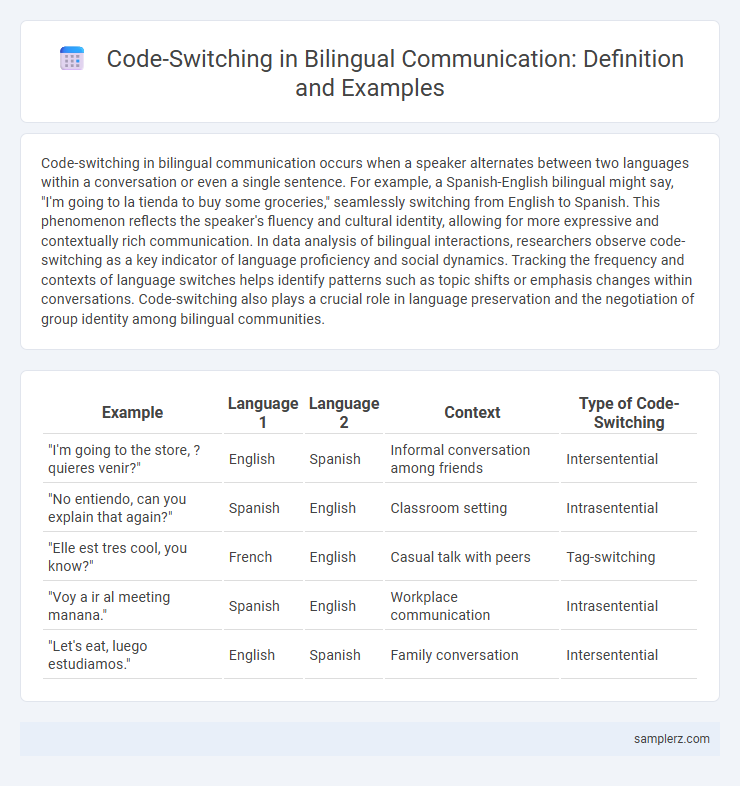Code-switching in bilingual communication occurs when a speaker alternates between two languages within a conversation or even a single sentence. For example, a Spanish-English bilingual might say, "I'm going to la tienda to buy some groceries," seamlessly switching from English to Spanish. This phenomenon reflects the speaker's fluency and cultural identity, allowing for more expressive and contextually rich communication. In data analysis of bilingual interactions, researchers observe code-switching as a key indicator of language proficiency and social dynamics. Tracking the frequency and contexts of language switches helps identify patterns such as topic shifts or emphasis changes within conversations. Code-switching also plays a crucial role in language preservation and the negotiation of group identity among bilingual communities.
Table of Comparison
| Example | Language 1 | Language 2 | Context | Type of Code-Switching |
|---|---|---|---|---|
| "I'm going to the store, ?quieres venir?" | English | Spanish | Informal conversation among friends | Intersentential |
| "No entiendo, can you explain that again?" | Spanish | English | Classroom setting | Intrasentential |
| "Elle est tres cool, you know?" | French | English | Casual talk with peers | Tag-switching |
| "Voy a ir al meeting manana." | Spanish | English | Workplace communication | Intrasentential |
| "Let's eat, luego estudiamos." | English | Spanish | Family conversation | Intersentential |
Real-Life Scenarios of Code-Switching in Bilingual Conversations
Code-switching frequently occurs in bilingual conversations when speakers alternate between languages to express concepts more precisely or to signal group identity, such as using Spanish and English interchangeably in casual conversations among Latina/o communities. In professional settings, bilingual employees might switch languages to clarify technical terms or ease client interactions, enhancing mutual understanding and rapport. Social media platforms and texting also serve as common arenas for code-switching, reflecting dynamic linguistic practices that reinforce cultural connections in real-life communication.
Code-Switching at Home: Family Communication Examples
Code-switching at home often occurs when bilingual family members alternate between languages to convey emotions or clarify meanings, such as a parent using one language to discipline and another to comfort. This linguistic practice facilitates nuanced communication and cultural connection within families, helping children develop bilingual proficiency. Common examples include mixing English and Spanish phrases during conversations or switching languages mid-sentence to express identity and belonging.
Workplace Code-Switching: Navigating Professional Settings
Workplace code-switching involves bilingual employees alternating between languages or dialects to adapt to professional contexts and enhance communication efficiency. For example, a Spanish-English bilingual employee may switch to English during client meetings for clarity, then use Spanish with colleagues to build rapport and share cultural nuances. This strategic linguistic flexibility fosters collaboration, streamlines problem-solving, and supports diverse workplace dynamics.
Code-Switching in Educational Environments: Student Interactions
Code-switching in educational environments occurs when bilingual students alternate between two languages during classroom discussions, group work, or peer interactions to enhance understanding and express complex ideas. This practice facilitates cognitive flexibility and cultural identity reinforcement while supporting academic learning through collaborative communication. Teachers observe that strategic code-switching promotes student engagement, especially in multilingual settings where students share diverse linguistic backgrounds.
Social Media and Digital Code-Switching Practices
Code-switching in bilingualism frequently appears on social media platforms where users alternate between languages within posts, comments, or hashtags to engage diverse audiences and express cultural identity. Digital code-switching also includes mixing languages in emojis, acronyms, and memes, reflecting nuanced social meanings and group belonging. This practice enhances communication flexibility and fosters inclusive online communities across linguistic boundaries.
Code-Switching During Multilingual Public Announcements
Code-switching during multilingual public announcements often occurs in airports, train stations, and healthcare settings where messages alternate between languages to address diverse audiences effectively. Speakers seamlessly shift between languages, such as English and Spanish or French and Arabic, to ensure clarity and inclusivity, adapting vocabulary and syntax to suit different linguistic groups. This practice enhances comprehension and accessibility, demonstrating the pragmatic use of bilingualism in real-time communication contexts.
Code-Switching in Popular Culture: TV, Film, and Music
Code-switching in popular culture often appears in TV shows like "Jane the Virgin" where characters seamlessly alternate between English and Spanish, reflecting authentic bilingual experiences. In films such as "Spanglish," the use of code-switching highlights cultural identity and adds depth to character interactions. Music artists like Cardi B frequently blend languages in their lyrics, showcasing code-switching as a dynamic tool for creative expression in bilingual communities.
Code-Switching in Peer Groups and Friendship Circles
Code-switching in peer groups and friendship circles often involves alternating between languages to convey specific social meanings or group identity. For instance, bilingual adolescents may switch from English to Spanish within conversations to express solidarity or emphasize cultural belonging. This dynamic use of language reinforces social bonds and facilitates nuanced communication among bilingual friends.
Emotional Expression Through Code-Switching in Bilingualism
Code-switching in bilingualism often serves as a powerful tool for emotional expression, where speakers alternate languages to convey feelings more effectively. For example, a bilingual individual might switch to their native language when expressing frustration or affection, as certain emotions are deeply rooted in the cultural context of that language. This linguistic shift allows for authentic emotional resonance and nuanced communication that may not be as easily achieved in the second language.
Code-Switching in Customer Service and Retail Interactions
Code-switching in customer service and retail interactions often involves bilingual employees alternating between languages to enhance clarity and build rapport with diverse clientele. For example, a sales associate may switch from English to Spanish to explain product features more effectively or address specific customer needs, improving overall communication efficiency. This linguistic flexibility not only fosters a more inclusive environment but also boosts customer satisfaction and loyalty in multicultural markets.

example of code-switching in bilingualism Infographic
 samplerz.com
samplerz.com